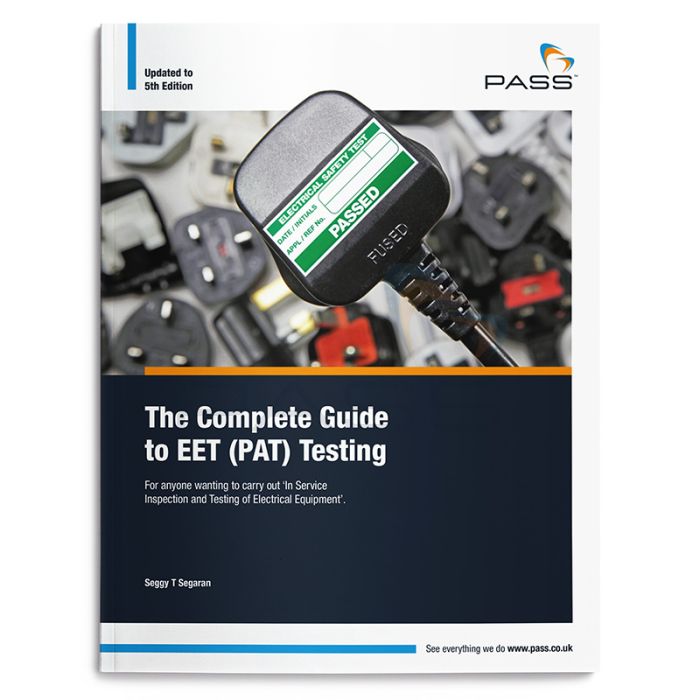PASS The Complete Guide to EET (PAT) Testing, 5th Edition

- Covers 5th Edition IET Code of Practice updates
- 129 page in-depth PAT/EET guide
- Easy to understand with lots of examples
Now updated to include the latest 5th edition changes to the IET Code of Practice.
What's New in the 5th Edition?
In 2020, IET launched Edition 5 of the 'Code of Practice for the In-Service Inspection of Electrical Equipment'. This introduced several significant changes and recommendations to portable appliance testing.
| Changes from Edition 4 to Edition 5 | |
| 1.) | No recommended test period anymore |
| 2.) | Every class of equipment has to have a document Risk Assessment by the Duty Holder which sets out the period of testing |
| 3.) | All equipment will have an insulation resistance; the leakage test is now an additional test |
| 4.) | Leakage test is 5 milliamps for all equipment (class 1 or class 2) |
| 5.) | New class of equipment class 2 FE |
| 6.) |
All types of equipment have changed to:
|
| 7.) | No reference to Portable Appliance Testing |
| 8.) | New legal documents to refer to |
| 9.) | Fuse ratings have changed |
| 10.) | Different standard marks on the fuses themselves |
| 11.) | Rack-mounted equipment (server rooms) has been introduced |
| 12.) | New symbol for Class 2 FE |
| 13.) | Class 3 equipment has a visual, although not tested |
The latest edition of our Complete Guide to EET (PAT) Testing reflects these new recommendations.
The Complete Guide to EET (PAT) Testing, 5th Edition Overview
The Complete Guide to EET (PAT) Testing, 5th Edition, written by Seggy T. Segaran in conjunction with PASS, is an informative PAT testing guide essential for anyone carrying out 'In Service Inspection and Testing of Electrical Equipment'. This reference guide is an invaluable resource for both new and experienced technicians.
Consisting of over 129 pages of easy-to-understand explanations, illustrated examples, and quick summaries, The Complete Guide to EET (PAT) Testing is the most comprehensive PAT testing guide available today. It contains practical PAT testing examples and explains the IET Code of Practice in colour-coded sections alongside photographic illustrations.
Whether sitting our Online PAT Testing Course, a PAT Competency Course, or a City & Guilds 2377 EET Course, our Complete Guide to EET (PAT) Testing, 5th Edition, will prove a useful source of information.
Complete Guide to EET (PAT) Testing Contents
Overview
Chapter 1: Why Do We Have to PAT Test?
Chapter 2: Health and Safety Executive Guidelines
Planning
Chapter 3: Getting Ready
Chapter 4: Class of Equipment
Chapter 5: Types of Electrical Appliances
Chapter 6: Work Environments
Chapter 7: How Often Do You Maintain Equipment?
Doing the Work
Chapter 8: Test Records and Labels
Chapter 9: User Checks
Chapter 10: Formal Visual Inspection
Chapter 11: Fuses
Chapter 12: Testing
PAT Testing: Technical Information
Chapter 13: Earth Continuity Test
Chapter 14: Insulation Resistance Test
Chapter 15: Earth Leakage Test
Chapter 16: Other Tests
Chapter 17: PAT Testers
Test Examples
Test Examples 1: Electric Kettles and Other Kitchen Appliances
Test Examples 2: Electric Fans and Heaters
Test Examples 3: Lamps and Other Household Appliances
Test Examples 4: Microwave Ovens
Test Examples 5: Power Tools and Other Workshop Appliances
Test Examples 6: Desktop PCs, Laptops, Monitors, and Other IT Equipment
Test Examples 7: IEC Leads and Mains Extensions
Test Examples 8: Residual Current Devices (RDCs)
Test Examples 9: 110v Transformers, Appliances, and Extensions
Test Examples 10: 3-phase Appliances and Extensions
Test Examples 11: Useful PAT Testing Adaptors
Appendices
Appendix 1: Basic Electrical Theory
Appendix 2: Wiring Plugs
Appendix 3: Cable Types
Appendix 4: Electrical Installation and Earthing
Appendix 5: Electric Shock
Appendix 6: Selling Second-hand Equipment
Appendix 7: Changes in Edition 5 of the IET Code of Practice
What is EET Testing?
EET, or 'Electrical Equipment Testing' is the preferred term for what was formerly known as PAT, or 'Portable Appliance Testing'. As such, all references to 'PAT' and 'Portable Appliance Testing' have been removed from IET's 5th Edition Code of Practice. This is because the terms ‘Electrical’ and ‘Equipment’ more accurately represent the types of instruments/tools that need to be tested: duty holders are required to make sure any electrical equipment in the building is safe for use, not just ‘portable appliances’.
This PAT testing guide still makes reference to 'PAT' and 'Portable Appliance Testing' as these terms remain in common use.



